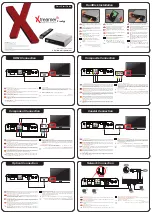
•
9
•
9. IF THE CONVERTER FUSE BLOWS
Your power converter is fitted with a fuse, which should not have to be replaced
under normal operating conditions. A blown fuse is usually caused by reverse
polarity or a short circuit within the device or equipment being operated.
If the fuse does blow:
1. Disconnect the device or equipment immediately.
2. Find the source of the problem and repair it.
3. Install a new fuse (40A). The fuse can be found on the right side of the
converter. NOTE: If you are using the 12V accessory plug to power the
converter, there is also a 15A fuse in the end of the plug.
IMPORTANT: Do not install a fuse with a higher amp rating than the original fuse,
as this may damage the converter and any product you use with the converter.
Make sure to correct the cause of the blown fuse before using the converter again.
10. TROUBLESHOOTING
PROBLEM
POSSIBLE CAUSE
SOLUTION
Red LED is on,
alarm sounds,
and/or converter
does not function.
Poor contact at terminals.
Connections are reversed.
Fuse is blown.
Converter shutdown.
Check for poor connection to
battery or power supply. Make
sure connection points are clean.
Rock clamps back and forth for a
better connection.
Unplug the converterer and
reverse the clamps.
See If the Converter Fuse Blows
section.
See LED Indicator and Shutdown
Protection section.
Device does
not operate
properly when first
connected to the
converter.
The converter may not have
the required capacity to
operate the device.
Turn the converter switch OFF
and ON, to reset the converter. If
device still does not operate, the
converter should not be used with
this device. Use a higher capacity
converter or lower rated device.










































